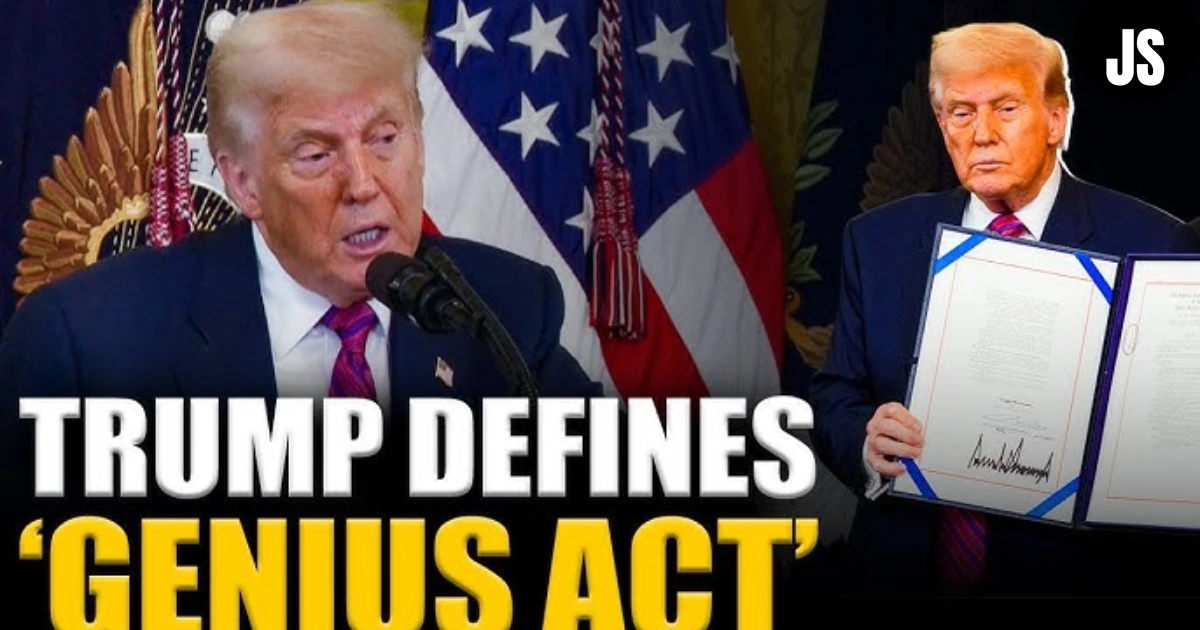President Trump signed the bipartisan GENIUS Act on July 18, 2025, establishing the first U.S. federal regulatory framework for stablecoins. Learn how it affects consumers, banks, retailers, and the crypto market.
Table of Contents
Trump Signs GENIUS Act into Law, Creating First U.S. Crypto Regulation for Stablecoins
On July 18, 2025, former President Donald Trump made waves by signing the landmark GENIUS Act into law—a bipartisan initiative described as the first comprehensive federal regulatory framework for U.S. stablecoins. This legislation, officially known as the Guiding and Establishing National Innovation for U.S. Stablecoins Act, aims to bring legal clarity, consumer protections, and banking-grade oversight to digital currencies pegged to the U.S. dollar.
🏛️ 1. What Is the GENIUS Act?
- Definition: The GENIUS Act creates a legal category for stablecoins—digital tokens pegged one-for-one to assets like the U.S. dollar or short-term Treasury securities.
- Key Requirements:
- Issuers must hold 100% reserves in liquid assets (e.g., dollar deposits, Treasuries).
- Monthly public disclosure of backing reserves.
- Mandatory annual audits for stablecoin issuers.
- Strict anti-money laundering and consumer protection rules.
- Rules for insolvency, giving holder claims priority over other creditors.
This measure also aligns federal and state oversight to prevent regulatory conflicts.
2. 🏛️ Legislative Journey & Bipartisan Support
- Introduced by Sen. Bill Hagerty (R–TN) on May 21, 2025.
- Senate Approval: June 17, 2025, with a 68–30 vote.
- House Approval: July 17, 2025, with a 308–122 bipartisan vote.
- Signing Ceremony: July 18, 2025, at the White House, with crypto industry leaders present.
As CBS News reported, the ceremony was widely attended—including figures from Coinbase, Kraken, Robinhood, and the Winklevoss twins.
3. 🧾 Why It Matters: The Crypto Industry Gains Legitimacy
A. Regulatory Clarity
The law replaces a fragmented regulatory landscape with clear federal standards—no more guesswork for banks and fintech firms looking to issue stablecoins.
B. Consumer Confidence
Public disclosures, audits, and the legal requirement for backing reduce risk and encourage broader use among consumers and businesses.
C. Mainstream Adoption
Big banks, retailers (e.g., Walmart, Amazon), and fintech firms can now explore issuing their own stablecoins—potentially reducing 2–3% in transaction fees by bypassing traditional card networks.
4. 💳 Industry & Market Response
- Crypto Market Surge: Following the signing, the global crypto market cap surpassed $4 trillion—Bitcoin reached ~$123,200, and Ether surged ~20% to $3,500.
- CoinFund’s Chris Perkins called it a milestone “serving as a foundational step in mainstreaming crypto”.
- Economic Forecast: Standard Chartered noted the stablecoin market could hit $3.7 trillion by 2030.
5. 🏦 Traditional Finance Meets Crypto
- Bank Entry: Banks and credit unions are gearing up to issue stablecoins—potentially revolutionizing their payment systems.
- Retail Giants: Pandering to cost-cutting needs, retailers like Amazon and Walmart may utilize stablecoins to eliminate merchant fees.
- Treasury Demand: Reserve requirements in Treasuries backed stablecoins could increase demand for U.S. government debt, strengthening the dollar’s status.
6. ⚖️ Controversies & Criticisms
- Consumer Safeguards: Some experts argue protections aren’t robust enough, especially for small investors.
- Big-Tech Dominance: Concerns that Amazon or Google could issue stablecoins without being regulated like banks.
- Money-Laundering Risks: Critics worry enforcement loopholes might open avenues for illicit finance.
- Digital Surveillance: The law’s requirement for issuers to freeze or seize tokens when legally ordered raises privacy concerns.
Notably, Senate’s Elizabeth Warren warned about national security risks and conflicts of interest involving Trump’s crypto ties.
7. 🌐 Strategic & Political Implications
- Trump’s Vision: The signing reinforces Trump’s narrative of making America the “crypto capital”—a shift from previous administrations’ caution.
- Global Leadership: The U.S. now leads in tech regulation, setting a model that rivals like the EU may follow.
- Crypto Week Momentum: The GENIUS Act joins the CLARITY Act and Anti-CBDC Surveillance State Act, all part of Congress’s “Crypto Week” push.
8. 📅 What Comes Next?
- Rulemaking Phase: Regulators have 6 months to draft implementation rules after signing
- Institutional Pilot Programs: Banks and fintech firms will begin regulated stablecoin issuance once rules are clear.
- Monitoring Enforcement: Watch for audits, reserve disclosures, and anti-fraud enforcement under the new framework.
9. ✅ Final Takeaways
| Key Point | Impact |
|---|---|
| First Crypto Law | Sets U.S. regulatory benchmark for stablecoins |
| Market Growth | Crypto market hit $4T + stablecoin expansion |
| Risk & Reward | Promises efficiency but raises privacy & AML concerns |
| U.S. Advantage | Positions U.S. as global crypto regulatory leader |
📌 Read More = Trump Sues Wall Street Journal for $10 Billion Over Epstein Letter Story
🔍 FAQs
Q1: What is a stablecoin?
A: A digital token pegged to assets like the U.S. dollar, aiming to maintain a stable value, unlike more volatile cryptocurrencies.
Q2: Why is stablecoin regulation needed?
A: To ensure consumer protection, reserve backing, and prevent fraud while paving the path for mainstream adoption.
Q3: How will consumers benefit?
A: Lower transaction fees, faster payments, improved trust via audits and disclosures.
Q4: Are there risks?
A: Yes—big tech growth, potential privacy issues, and AML loopholes are key challenges flagged by experts.
Q5: When do these new rules start?
A: Regulators have until early 2026 to finalize rules, after which banks and issuers can begin operations
